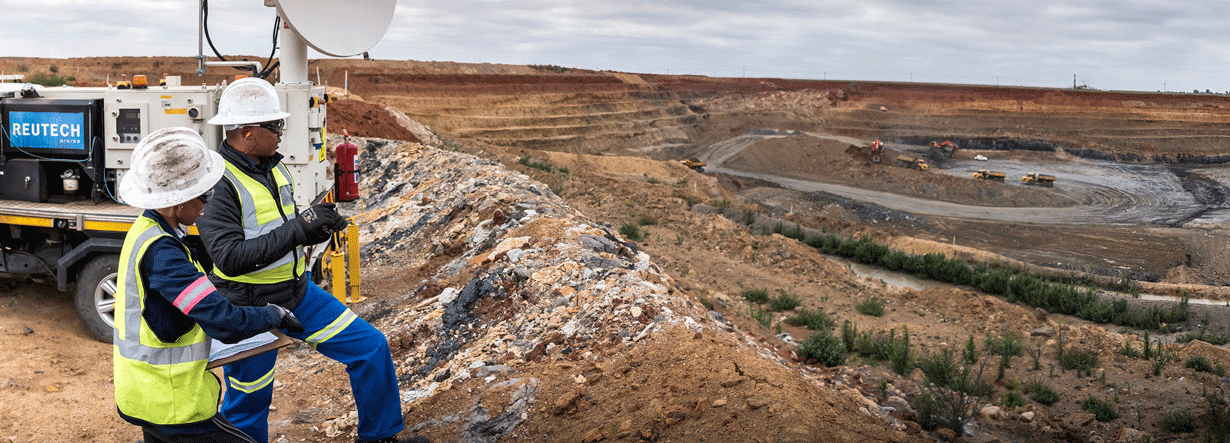Exxaro Resource limited Report Selector 2018




Currently viewing Mineral Resources Report 2018




Currently viewing Mineral Resources Report 2018
The estimation process is summarised below and applies to all coal operations and projects under Exxaro's management control. The resource competent person (CP) is actively involved throughout the process and no data is included/excluded without their consent.
The resource estimation process for Coal Resources under Exxaro's control is governed by the group's resource estimation procedure and aligned to the SAMREC Code 2016 and SANS 10320:2004 standard. The data used for resource estimation is managed by separate commodity-specific procedures through which core recovery and logging, sampling, quality assurance and control, relative density determination and wireline logging standards are enforced. These standards were updated in 2017 to comply with SAMREC 2016 and SANS 10320:2004 but aspects aligning with the SANS 10320:2017 draft standard are considered where applicable.
The core recovery standard (>95% in coal seams for valid points of observation) as stipulated in SAMREC 2016 and SANS 10320 standard is not always empirically enforced due to unavailability of digital core recovery data for pre-2017 boreholes. However, Exxaro competent persons confirm that there is high confidence in core and sample recovery for all boreholes used for resource estimation purposes and any deviation is managed by increased geological losses within geological loss domains, downgrading resource classification, and/or redrilling boreholes. Core recovery is continuously reviewed, and any shortcomings are actively addressed through downhole geophysical surveys, seam validations and redrilling.

For Coal Resources, relative density (air-dried) is determined by accredited laboratories using the Archimedes method in all instances, except for Grootegeluk mine and the Thabametsi project, where relative density is determined using an on-site mine laboratory application of the Archimedes method and results are continuously used to validate core recovery. A comparative study between the field and laboratory methods was undertaken in 2015, and results Indicated no significant difference.
A formal, annually compiled, integrated and signed-off exploration strategy outlines planned activities to investigate areas of low confidence and/or geological or structural complexities to ensure resources with a high level of geological confidence are considered for mine planning. Exploration plans are available as supplementary information to the competent person's report (CPR).
The resource estimation process is summarised below and applies to all coal operations and projects under Exxaro's management control. The resource competent person (CP) is actively involved throughout the process and no data is included/excluded without their consent.
Table 11: Summary of estimation considerations
| Item | Description | ||||
| Resource fact pack | Lists new information since last estimation, together with a reconciliation between predicted MTIS and actual MTIS. Recommendations from internal/external audits are included. | ||||
| Technical data validation | Technical validation of data to be used for resource estimation, including collar validation, gaps and overlaps checks, data distribution, etc. | ||||
| Data analysis | Entails a review and analysis of the geological integrity and continuity of data in a spatial and geostatistical sense. Includes domaining and structural interpretations. | ||||
| Data modelling | Geovia Minex is used for coal modelling and the Minex growth algorithm is the preferred interpolation technique. ESRI ArcGIS is used for modelling structural features. Sable Data Warehouse (SDWh) or Minex is used for coal compositing and, in both instances, representative substitute values are used for unsampled non-coal material. The geological model and structural interpretation are presented by the resource CP, aided by relevant technical specialists, to a panel comprising Exxaro lead CP and domain experts for sign-off and approval. Concept-level geological models, where applicable, are compiled for alternative interpretations and these risks are evaluated during sign-off. Feasibility-level and/or LoMP-level geological models are based on reviewed and signed-off interpretations. | ||||
| Resource classification | Resource classification follows the Exxaro estimation procedure and is aligned with SANS 10320:2004 and the consideration of RODA. Anomalous borehole data and structurally complex areas are accounted for and resource classification is used to control the adequacy of borehole data. Separate confidence zones are determined for structural features based on a matrix approach. The effect of extrapolation is controlled by resource classification in which classification domains are not extrapolated beyond half the average borehole spacing for the classification category. Only points of observation with applicable quality data are used for classification. | ||||
| Estimation and reporting | Resource reporting uses approved cut-offs and geological loss domains, followed by completing all necessary reports and audit trails. Exxaro currently uses a systematic and integrated review process that measures the level of maturity of exploration work done, the extent of geological potential, licence-to-operate and associated geological risks to establish an eventual extraction (EE). The criteria for assessing reasonable prospects for eventual economic extraction (RPEEE) are shown in table 12. Reporting includes technical information that requires subsequent calculations to derive subtotals, totals and weighted averages. Such calculations may involve a degree of rounding and consequently introduce an error. Where such errors occur, Exxaro does not consider them material. |
||||
| Review and consolidation | Individual reports are reviewed, and corrections effected if necessary. Reports are endorsed by management and used to compile the consolidated Coal Resources and Coal Reserves report. |
Table 12: Exxaro considerations for reasonable prospects for eventual economic extraction (RPEEE)
| Item | Criteria | Considerations | ||||
| Geological data | Data has been validated and signed off by competent person | Seam depth and extent, seam thickness, structure and seam quality (cut-off) | ||||
| Geological model | Geological model has been considered and signed off | |||||
| Structural model | Structure model was considered and signed off | |||||
| Mining | Mining assumptions considered and defined | Mining method, inputs from metallurgist, rock engineer and hydrogeologist | ||||
| Assurance | Minimum tier 1 assurance as per Exxaro governance and assurance framework | As per tier 1 requirement | ||||
| Economic evaluation | A concept-level exploitation and economic evaluation that quantifies economic potential based on economic and mining assumptions, including geotechnical and geohydrological assumptions | Preliminary appraisal of layout, cost and profit | ||||
| Environmental | An assessment of potential impediments is done and, if any exist, there should be a reasonable expectation that these will be resolved. Reasonable demonstration that environmental approvals can be obtained within the context of local, regional and national legislation | |||||
| Tenure | Formal tenure must be demonstrated. If any potential impediments exist, there must be a reasonable expectation that these will be resolved. If a prospecting right, there should be reasonable demonstration that a mining right approval can be obtained within the context of local, regional and national legislation | |||||
| Infrastructure | Assumptions used should be reasonable and within known/assumed tolerances or have examples of precedence. Any potential impediments should have a reasonable expectation that they will be resolved. Power, water and transport considered | |||||
| Market | A potential market for the product that is planned to be extracted from the resource with a reasonable assumption that this market is sustainable | |||||
"Reasonable prospects for eventual economic extraction should be demonstrated through the application of an appropriate level of consideration of the potential viability of Coal Resources. Such a consideration should include a reasoned assessment of the geological, mining engineering, processing, metallurgical, legal, infrastructural, environmental, marketing, socio-political and economic assumptions which, in the opinion of the competent person, are likely to influence the prospect of economic extraction. All of the issues listed in table 1, under reasonable prospects for eventual economic extraction, should be discussed to the level appropriate for the specific investigation." SAMREC, 2016 edition
We have enhanced our current process to consider all aspects as per SAMREC 2016 (table 1, 4.3) to establish reasonable prospects for our operations and projects. Each operation/project's RPEEE is presented in the ancillary section. We continuously examine our criteria to review the probability of extraction and to identify any areas where potential risk may exist.
Coal reserves are estimated using the relevant modifying factors at the time of reporting (mining, metallurgical, economic, marketing, legal environmental, social and regulatory requirements). Modifying factors are signed off before and after reserve estimation by the persons responsible for ensuring that all factors are timeously and appropriately considered. Comprehensive modifying factor sign-off and reserve fact packs that record losses, recoveries/yields and other factors applied are documented in each independent CP's report.
Exxaro is keenly aware of the importance of its mineral assets, both for the short-term profitability of its operations and the sustainability of the company. The optimisation of mineral assets beyond what is generally referred to as Mineral Resource management is being driven as a priority. Changes in the resources market, increased awareness of protecting the natural environment and changing legislation and statutory requirements demand a change in the utilisation strategy and execution of mining operations. Exxaro continuously assesses the various life-of-mine strategic plans to consider the best way of addressing these challenges.
For Coal Reserve estimates to comply with life-of-mine policy, the following supporting inputs are required for all reserve estimates: survey, rock engineering, infrastructure, legal, processing, social, political and environmental as well as a reserve estimation scoping report.
The following outputs are generated after successfully completing the procedure: validation and verification report, mining block model, exploitation strategy report, mining schedule and equipment strategy report, and reserve estimation report.
At the start of the estimation process, the applicable reserve CP must compile, for every operation, a reserve fact pack report outlining the standards and norms of that operation as well as all relevant planning standards. Also considered are all standards and norms and planning parameters, the geological model, infrastructure and environmental plans together with the structural plan, geotechnical review report, and others. The market strategy, supply contracts and planned volumes drive the schedule. All operations standards must be signed off by the applicable mine management and reserve CP. A similar procedure is followed for projects, with the project steering committee fulfilling the role of mine management.
Reserve estimation may be conducted either as required, eg for a project-stage evaluation, or as part of the annual Mineral Resource and Mineral Reserve estimation process. The data conversion, validation and verification report are the first outputs of this procedure.
On receipt of the geological model, the validation procedure is run, and the model is converted into a mining model, after which a report is compiled with possible geological model anomalies, and a comparison of volumes in the geological model and mining model to confirm data conversion has been carried out correctly. This information is signed off as acceptable by the resource CP and manager: strategic mine planning and design.
The following components are included in the LoMP and reserve estimation: exploitation strategy, operational methodology and pit shell.
The exploitation strategy needs to broadly demonstrate the pit/mining economics, in terms of resource boundaries, legal and other, ie servitudes. For example, when converting the resource to reserve, explain the economics, in terms of stripping ratio, underground versus open-pit, etc. Lastly, the extraction sequence of mining different areas in terms of access, economics or other criteria deemed most appropriate.
Operational methodology considers:
Resource volumes/tonnages are converted to reserve tonnages by applying the following mining modifying factors:
The reserve classification methodology for Coal Reserves under Exxaro's control is governed by the Exxaro Coal Reserve estimation procedure, as described in the LoMP policy, and aligned to the SAMREC 2016 and SANS 10320:2004 standard. In general, Measured Resources are converted to Proved Reserves and Indicated Resources are converted to Probable Reserves. If an operation or project has additional constraints, ie a supply agreement that has not been finalised or a sales/marketing strategy that limits the profitability of the mine, the Measured Resources can be downgraded to Probable Reserves. In situations where this has been applied, it is clearly stated in the footnotes for the reserve's tables.
Where Inferred Resources were considered for life-of-mine plans, the amount (Mt) and effect is always clearly stated. When Inferred Resources are included in the LoMP, these tonnages are never scheduled in the first five years of mine life. The rationale for considering Inferred Resources inclusion is explained and actions to address this issue are stated and Exxaro generally attempts to limit Inferred Resources to less than 15% of total resources to be considered for LoMPs. Any inclusion of Inferred Resources must be tested, reported and modifying factors and assumptions that were applied to the Indicated and Measured Resources to determine the Coal Reserves must be equally applied to the Inferred Resources. However, Inferred Resources are not converted to Coal Reserves and are not stated as part of the Mineral Reserve. The amount of Inferred Resources considered for the reported LoMP is included in the reserve statement.
